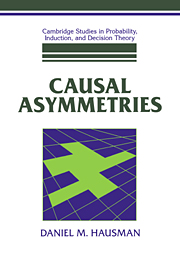Book contents
- Frontmatter
- Contents
- List of Figures
- Acknowledgments
- Introduction: Causation and its Asymmetries
- 1 Metaphysical Pictures and Wishes
- 1* Transfer Theories
- 2 Is Causation a Relation Among Events?
- 3 Causation, Regularities, and Time: Hume's Theory
- 4 Causation and Independence
- 4* Causation, Independence, and Causal Connection
- 5 Agency Theory
- 5* Causal Generalizations and Agency
- 6 The Counterfactual Theory
- 6* Independence and Counterfactual Dependence
- 7 Counterfactuals, Agency, and Independence
- 7* Agency, Counterfactuals, and Independence
- 8 Causation, Explanation, and Laws
- 8* Causation, Explanation, and Independent Alterability
- 9 Probabilistic Causation
- 10 Causation and Conditional Probabilities
- 10* Causal Graphs and Conditional Probabilistic Dependencies
- 11 Intervention, Robustness, and Probabilistic Dependence
- 11* Interventions and Conditional Probabilities
- 12 Operationalizing and Revising the Independence Theory
- 12* Probability Distributions and Causation
- 13 Complications and Conclusions
- Appendix A Alphabetical List of Propositions
- Appendix B List of Theorems
- References
- Index
8 - Causation, Explanation, and Laws
Published online by Cambridge University Press: 20 April 2010
- Frontmatter
- Contents
- List of Figures
- Acknowledgments
- Introduction: Causation and its Asymmetries
- 1 Metaphysical Pictures and Wishes
- 1* Transfer Theories
- 2 Is Causation a Relation Among Events?
- 3 Causation, Regularities, and Time: Hume's Theory
- 4 Causation and Independence
- 4* Causation, Independence, and Causal Connection
- 5 Agency Theory
- 5* Causal Generalizations and Agency
- 6 The Counterfactual Theory
- 6* Independence and Counterfactual Dependence
- 7 Counterfactuals, Agency, and Independence
- 7* Agency, Counterfactuals, and Independence
- 8 Causation, Explanation, and Laws
- 8* Causation, Explanation, and Independent Alterability
- 9 Probabilistic Causation
- 10 Causation and Conditional Probabilities
- 10* Causal Graphs and Conditional Probabilistic Dependencies
- 11 Intervention, Robustness, and Probabilistic Dependence
- 11* Interventions and Conditional Probabilities
- 12 Operationalizing and Revising the Independence Theory
- 12* Probability Distributions and Causation
- 13 Complications and Conclusions
- Appendix A Alphabetical List of Propositions
- Appendix B List of Theorems
- References
- Index
Summary
Several features of the causal relation suggest a close connection between causation and explanation.
The relevant aspects of cause and effect make reference to properties and do not appear to be fully concrete entities.
The relations between causation and laws and the scientific centrality of type-causal claims force one to emphasize the role of properties in the causal relation.
The importance of absences and nonoccurrences in causal relations and the fact that the same pair of substances can be the locus of causal relations in either direction, depending on context, all call into question a view of causation as a purely physical relation of the sort suggested by transfer theorists.
The relativization of causal relations to particular fields or systems points to links between causation and explanation.
A connection between independence and explanation is implicit in the thought explored at the ends of chapters 5 and 7 that independence should be regarded as specifying the circumstances in which causal relations obtain – or in which causal explanations are appropriate.
So something must be said about the intimate relations between explanation and causation. For millennia, citing a cause has been taken to be explaining. When Aristotle presents his doctrine of the four kinds of causes, he is developing an account of four different kinds of explanations one may give. Material causes of objects are explanations of their properties in terms of the material of which they consist. Formal causes are explanations in terms of structure. Final causes are explanations in terms of ends. Proximate causes – causes in our modern sense – are apparently linked to explanation as well.
- Type
- Chapter
- Information
- Causal Asymmetries , pp. 156 - 175Publisher: Cambridge University PressPrint publication year: 1998



